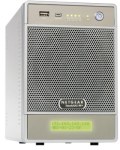 For quite some time I haven’t been happy with the level of data protection on my servers … a while ago I ran mirrored (RAID 1) IDE (PATA) drives on my system using a Arco Duplidisk adapter. It seemed adequate, but after I upgraded my servers to the Dell PowerEdge systems, it didn’t seem to work quite right. It was reporting failed drives when there were none.
For quite some time I haven’t been happy with the level of data protection on my servers … a while ago I ran mirrored (RAID 1) IDE (PATA) drives on my system using a Arco Duplidisk adapter. It seemed adequate, but after I upgraded my servers to the Dell PowerEdge systems, it didn’t seem to work quite right. It was reporting failed drives when there were none.
So, after a fair bit of research, I decided to get a NAS (Network Attached Storage) device. My criteria were a) had to support various RAID levels (1 & 5 at least), have hot swappable drives, and support NFS (the linux network file system).
The device I decided on is a Netgear ReadyNAS NV+. The model I got came with 2 x 500gb drives, with bays for two more. It wasn’t cheap, but I think it will be worth it in the long run.
It supports various RAID levels … RAID 1 (mirroring, where the data on one drive is completely duplicated on the other), RAID 5 (where data is stored on two drives with a parity bit on the 3rd … if any one of the drives fails, the data can be reconstructed on the fly using two of the drives), and it’s own RAID X … which is an eXpandable and adaptive RAID variation … which will use RAID 1 if you only have two drives, and RAID 5 when you add more.
Although there were a few hiccups, I’m not displeased.
A few items of note …
- It’s VERY quiet. The only noise I can really note is the drive access.
- Adding a drive is simplicity itself. Just pull an empty bracket from the unit, add the drive (they even provide screws), put the bracket back in. The device immediately notices a drive was added and starts preparing it. Once the preparation is done, you’re told to restart the unit so it can recognize the new space. All these notifications appear on the web interface and, if configured, via email. It also can send notifications via SNMP, but I haven’t figured out SNMP yet (in general).
- It has built in multimedia servers … iTunes, UPnP, and a few others. Haven’t had a chance to play with them much, but it looks promising.
- It supports SMB (Windows), NFS (Linux), AFP (Apple) for file sharing, as well as FTP, HTTP, and RSYNC (which is a common way of transferring files efficiently on Linux) for file transfer.
- It has the ability to use other add-ons. I haven’t played with that much. It comes with a BitTorrent client and a photo album app.
- It will monitor a UPS attached to one of it’s USB ports.
- It can back itself up in various ways … from a USB drive attached to one of the 3 USB ports to transferring the backup to a file share on another system.
- It’s quite upgradable … both disk and memory … and will still be under warranty as long as you use their recommended hardware.
As with most things … there were a few glitches …
- The documentation, while OK … isn’t perfect. The manual indicated that the default admin password for the unit was ‘INFRANT1’ (name of the company that produced the device before Netgear bought them) … but, since the unit I had was running version 4.x of the firmware, the default password was now NETGEAR1. Took a bit of digging to figure that out.
- It uses the web for administration … and it’s a pretty good implementation. But the particular version of the firmware initially installed on the unit had a problem with Firefox 3. I had to use IE to upgrade the firmware to 4.1.4 in order to get it to work with FF 3.
I’ve moved my websites (including this blog) and Ginny’s over to the Readynas. I’m going to let it run for a week or two like that before moving more data over. Obviously I still have the original data backed up.
More info as I discover it.
A small correction – with RAID 5, both data and parity are striped. What you described is actually RAID 3 which I’ve never seen implemented in a production environment.
Be sure to check out the forums over at http://www.readynas.com for more information on what you can do with this thing. It isn’t the fastest model but it is pretty solid for a home user.
The default password is in lowercase. It is case sensitive.